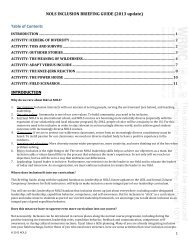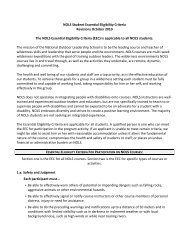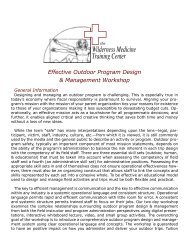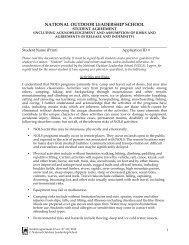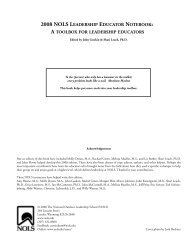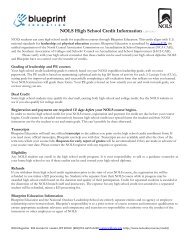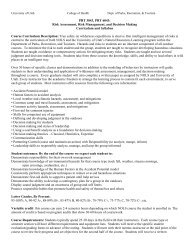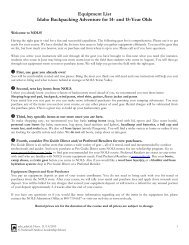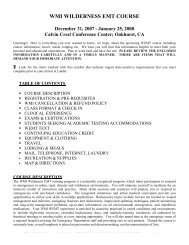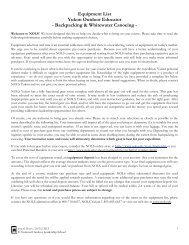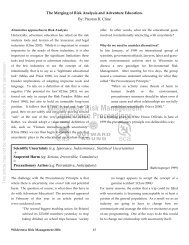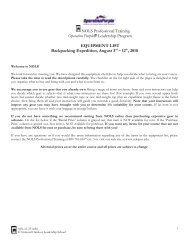Course Description Rocky Mountain Instructor Course - NOLS
Course Description Rocky Mountain Instructor Course - NOLS
Course Description Rocky Mountain Instructor Course - NOLS
Create successful ePaper yourself
Turn your PDF publications into a flip-book with our unique Google optimized e-Paper software.
<strong>Course</strong> <strong>Description</strong><br />
<strong>Rocky</strong> <strong>Mountain</strong> <strong>Instructor</strong> <strong>Course</strong><br />
Learning Outcomes for this <strong>Course</strong><br />
The foundation of the <strong>NOLS</strong> <strong>Mountain</strong> <strong>Instructor</strong> course is to prepare students to: assume leadership roles in their lives and<br />
work through excellent teamwork, communication, and expedition behavior; live, travel, teach, and manage risk in mountain<br />
environments while applying the outdoor skills practiced on this course; apply effective decision-making tools to unfamiliar<br />
problems; inspire students to connect with natural places and foster a strong environmental ethic, and participate as an<br />
effective team member and educator on their first <strong>NOLS</strong> course as an instructor. The following course features define the<br />
likely activities that will support this learning:<br />
Features Of This <strong>Course</strong>:<br />
• <strong>Course</strong> Length: 35 days<br />
• Backcountry hiking and climbing expedition (front-country climbing for May courses) that emphasizes teaching the<br />
<strong>NOLS</strong> curriculum: mountain backpacking, technical climbing, and wilderness living and travel skills<br />
• Group size: 12 students & 3 instructors<br />
• Hiking route: 50~100 miles<br />
• Average age: 27<br />
• Minimum age: 21<br />
• On and off-trail hiking<br />
• Opportunities for technical peak ascents, rock climbing, teaching, leading, fishing, and natural history<br />
• Black and Grizzly bear habitat<br />
• Average pack weight: 60 pounds<br />
The Expedition<br />
The <strong>Rocky</strong> <strong>Mountain</strong> <strong>Instructor</strong> course is conducted in the Wind River Range of Wyoming, a rugged, glacier-carved range<br />
renowned for its sheer granite walls and famous for it’s fishing and climbing. Its towering peaks, glistening alpine lakes, and<br />
perennial snow make a perfect classroom for furthering wilderness travel techniques, outdoor living skills, and<br />
mountaineering. On this course, you’ll develop and refine the teaching, leadership, and technical skills necessary to prepare<br />
you for professional positions at <strong>NOLS</strong> and other wilderness programs.<br />
The <strong>Mountain</strong> <strong>Instructor</strong> course is conducted three times each summer in Wyoming. The basic curriculum, expectations, and<br />
outcomes for the <strong>Instructor</strong> <strong>Course</strong> are similar regardless of start date.<br />
The early May course is divided into two sections—a three-week backpacking expedition in the Wind River <strong>Mountain</strong>s<br />
followed by a climbing base camp at either Split Rock or Lankin Dome, both on the high plains of central Wyoming. Due to<br />
unpredictable mountain weather and lingering winter snowpack in the spring, the hiking portion of this course often entails<br />
camping and traveling on snow for most, if not all, of its duration. The climbing section is a stationary camp that will cover<br />
the <strong>NOLS</strong> rock climbing teaching progression, some rock rescue techniques, and top rope site management. You will also be<br />
able to develop further climbing skills related to leading and multi-pitch climbs. This course is designed to prepare<br />
participants for working wilderness hiking courses for <strong>NOLS</strong>. For qualified participants, it will also include the opportunity to<br />
be assessed to work climbing courses, though being a rock climber is not necessary for having a successful <strong>NOLS</strong> career.<br />
The late May course will take place entirely in the backcountry of the Wind River <strong>Mountain</strong>s. This course will cover the full<br />
curriculum needed to work wilderness hiking courses for <strong>NOLS</strong>, including leadership progression, navigation, off-trail travel,<br />
river crossings, travel on steep snow, and fly fishing. Exposure to the climbing curriculum will be more limited on this course,<br />
but will include all skills necessary to be an effective wilderness instructor, such as 3 rd and 4 th class terrain and top rope site<br />
management. This course will likely begin with the majority of camping and traveling taking place on snow. As early season,<br />
spring conditions give way to summer, you may find yourself seeing the earliest wild flowers of the season as the mountains<br />
begin to dry out. The dynamic conditions at time in the mountains will present the opportunity to learn a great deal about the<br />
various conditions encountered on a typical, early season <strong>NOLS</strong> hiking course.<br />
The course beginning in July will also take place entirely in the Wind River <strong>Mountain</strong>s. This course will be a self-contained<br />
backpacking expedition of more than 30 days, with two re-rations by horse packers. This IC is designed to prepare<br />
sic.cd.13 rev. 10/24/2012<br />
© National Outdoor Leadership School<br />
1
participants for working wilderness hiking courses for <strong>NOLS</strong>. For qualified participants, it may also include the opportunity<br />
to be assessed to work climbing courses. Depending on weather, participants on this course may have the ability to learn top<br />
rope site management skills, multi-pitching techniques, and mountaineering and glacial travel skills. This course presents<br />
excellent opportunities to travel extensively through the mountains, concentrating on navigation, river crossings, peak ascents,<br />
and local flora, fauna, and ecology.<br />
The instructor course will start in Lander with two days of in-town classes and activities focusing on issuing gear and rations,<br />
taking a WFR level first aid test, and discussing <strong>NOLS</strong> history, leadership theory, and group management and supervision<br />
techniques. During the two days in town, you’ll also have time to research and prepare classes. Then you’ll head off to the<br />
mountains to begin your expedition. For participants on the early May IC, between the backpacking and climbing sections,<br />
you will return to Lander for a very brief period to reorganize gear and rations.<br />
As noted above, you will be responsible for teaching basic and advanced classes in the field. Wilderness living skills, natural<br />
history, environmental ethics, expedition behavior, and communication skills are all-important parts of the curriculum. You’ll<br />
be challenged to experiment with different teaching styles while polishing your skills, judgment, leadership, and supervisory<br />
abilities. Peer and staff feedback of class content, teaching techniques, and effectiveness as an educator are all essential parts<br />
of the learning process.<br />
Risk assessment in wilderness situations is a critical element of outdoor leadership. Your instructors will teach most of the risk<br />
management-related classes including river crossings, emergency procedures, and rock and snow climbing. Hazard evaluation,<br />
accident prevention, group management, and evacuation procedures are thoroughly discussed and practiced on the course.<br />
Students will be evaluated on their first aid skills and knowledge. Practical scenarios will be used during the course.<br />
Climbing is an important component of the <strong>NOLS</strong> curriculum and is taught and evaluated on the <strong>Mountain</strong> <strong>Instructor</strong><br />
<strong>Course</strong>. After completing a careful progression of instruction and climbing, students are expected to set up and supervise top<br />
rope and rappel sites in diverse mountain settings. Emphasis is also placed on developing lead climbing skills (as appropriate<br />
with student ability) and managing students in a climbing setting. However, climbing activities will only make up a relatively<br />
small percentage of the course time. In fact, mountain weather may prevent climbing activities from taking place at all.<br />
During the <strong>Instructor</strong> <strong>Course</strong> you will live in small groups of three or four to minimize your impact on the land and to hone<br />
your camping skills. You will also travel in small groups from camp to camp in order to enhance learning and the wilderness<br />
experience.<br />
Student Independence<br />
On all <strong>NOLS</strong> courses students will be independent (unaccompanied by instructors) at various times. This will include time in<br />
and around camp such as while cooking or performing camp chores. <strong>Instructor</strong>s may allow students to travel away from camp.<br />
Students often have independent unsupervised time, usually in town, before and after their course starts or between sections.<br />
Students are expected to maintain the same level of expedition behavior and adherence to <strong>NOLS</strong>’ drug/alcohol/tobacco<br />
policy while transitioning between sections and while staying at the Noble Hotel, Three Peaks Ranch, or the Vernal River<br />
Base.<br />
Independent Student Group Travel<br />
An emphasis of this course is the development of skills that permit you to be self-sufficient in remote backcountry areas. Our<br />
teaching progression for accomplishing this is carefully planned and executed. Initially travel groups, usually of four to six<br />
students, will include an instructor who will teach travel skills and leadership. Gradually, as you gain proficiency, the instructor<br />
will allow you to take on more responsibility and make more of the decisions. When you have demonstrated the necessary<br />
competency to the instructors, you may travel in student-led groups without instructors for a day at a time as you hike from<br />
camp to camp. We call this daily independent student travel and it is an effective educational tool. It allows you to practice<br />
travel skills and leadership and gives you responsibility for the outcome while still having indirect supervision by instructors<br />
and the benefit of the <strong>NOLS</strong> support systems.<br />
This course may culminate in a Student Expedition. After successful practice with daily independent student travel and if your<br />
instructors think your group is ready, the instructors will help you divide into student expedition groups (usually three to six<br />
students each.) With instructor oversight, each group will then select a leader and carefully plan and execute a multi-day<br />
sic.cd.13 rev. 10/24/2012<br />
© National Outdoor Leadership School<br />
2
independent student led expedition. This part of the course builds on the skills you've learned and practiced and allows you to<br />
travel without instructors for multiple days. Students are aware of where the instructors and the other student groups are<br />
planning to travel and camp. Each Student Expedition group will carry an emergency communication device that will allow<br />
students to initiate an emergency response in the event of a serious emergency. In most cases students will have a personal<br />
locator beacon, but in some situations they will have a satellite phone, cell phone, radio or possibly another type of device. The<br />
instructors with a satellite phone, or additional communication capability, may be up to 24 hours away from the students. Our<br />
students often say the student expedition was the highlight of their course.<br />
Fasting is an optional part of the curriculum for the student expedition on this course. If the instructors think fasting is<br />
appropriate for the conditions and student abilities the students may chose to fast during the student expedition. Rations will<br />
be carried to allow students to eat in the event of an emergency.<br />
Evaluations and Future Employment<br />
<strong>Instructor</strong>s evaluate students in the following areas: Risk management and judgment, teaching, communication, expedition<br />
behavior, leadership, conservation practices, outdoor, and climbing skills. At the conclusion of the course, each student<br />
receives a written evaluation documenting his or her abilities. Those who complete the course and do well are eligible to work<br />
a land-based course as an instructor at <strong>NOLS</strong>. Currently, about 80 percent of those passing eventually work for <strong>NOLS</strong>, but<br />
job opportunities cannot be guaranteed. Those who wish to be available for fieldwork during the same summer as their<br />
<strong>Instructor</strong> <strong>Course</strong> are advised to apply for an early date.<br />
We look for initiative, creativity, and potential for growth as a wilderness educator. We operate on the premise that there is<br />
always more to learn and areas in which to grow no matter what the skill level, knowledge, or experience. The <strong>Instructor</strong><br />
course is a demanding learning experience, and there is little free time. Those who do well on a <strong>NOLS</strong> <strong>Instructor</strong> <strong>Course</strong><br />
bring a positive attitude toward learning and growing, a respect and support for others, and a care and enjoyment of the<br />
natural environment.<br />
Weather and Other Challenges<br />
<strong>NOLS</strong> takes great pride in providing quality experiential education on all courses. Expeditions, unlike traditional classrooms,<br />
are influenced by weather, terrain, and the characteristics of the individuals involved. Accordingly, <strong>NOLS</strong> courses are not fully<br />
scripted and this quality is the key ingredient in experiential education. The activities we choose will depend on the conditions<br />
we experience, but every weather variable and condition provides some opportunity for learning. As an example, while early<br />
season snow may make rock climbing less realistic, it provides more opportunity for learning how to snow climb. Recognize<br />
that given the variables affecting all <strong>NOLS</strong> courses, the depth of topic coverage will vary from course to course. The<br />
foundation of a <strong>NOLS</strong> expedition is learning from the experiences you face.<br />
<strong>Mountain</strong> weather is capricious. On any given day, temperatures may range from below freezing to sweltering. Afternoon<br />
thunderstorms are common and can be quite violent. <strong>Course</strong>s may experience snow and rain, or long stretches of sun and<br />
blue skies.<br />
Travel in the mountains can be tough. Early season courses may spend most of their time camping on snow and using<br />
snowshoes to travel. Other times, you’ll bushwhack through thick forests or scramble around boulders the size of<br />
refrigerators. Rivers are icy from snowmelt and can be difficult or impossible to cross. You'll traverse steep slopes of snow,<br />
loose rock, or grass, and grunt up high-mountain passes. There will be times when you will wish you were somewhere else, but<br />
the hard work is worth it. There’s nothing quite like taking your pack off at the top of a pass, feeling the wind dry the sweat<br />
off your back, and looking down at miles of new country opening up before you. It’s exhilarating!<br />
Camping may involve dealing with swarms of mosquitoes and hanging your food to keep it away from bears or other animals.<br />
You’ll be miles from the amenities of civilization. Telephones, ambulances, and hospitals may be several days away.<br />
This course travels through grizzly and black bear habitat. <strong>NOLS</strong>, in collaboration with bear biologists, has developed specific<br />
practices to minimize the risk of a bear encounter. Your instructors will teach these practices to you and you will have to<br />
follow them every day. Bear avoidance practices include carrying bear deterrent pepper spray, meticulously maintaining<br />
cleanliness at the cooking sites, and at times if the situation warrants, making loud calls to warn bears of your presence when<br />
moving through areas where visibility is poor and not being alone. Precautions against bear encounters may decrease the<br />
sic.cd.13 rev. 10/24/2012<br />
© National Outdoor Leadership School<br />
3
opportunities for solitude and privacy on this course.<br />
Identifying and managing mountain hazards—such as falling rock, weather, animals, moving water, and steep terrain—will be<br />
a constant theme in our instruction. Managing risks and assuming responsibility for yourself and your colleagues will help<br />
make your expedition in these wild mountains healthy and fun.<br />
Personal Electronics<br />
A key element to a <strong>NOLS</strong> education is time spent in wilderness. The benefits of this include being closer to nature, time away<br />
from society and civilization, and being in an environment where natural forces predominate and students have the<br />
opportunity to develop good judgment and practice self-reliance. <strong>NOLS</strong> does not permit students to use personal cell or<br />
satellite phones or other communication devices including personal tracking devices (e.g. SPOT), while in the field.<br />
Additionally, students are not permitted to take personal music players (iPods/MP3 players, etc). <strong>Instructor</strong>s will be carrying<br />
sufficient communication equipment (usually a satellite phone) to handle emergencies that may arise.<br />
<strong>Mountain</strong> <strong>Instructor</strong> <strong>Course</strong> Objectives<br />
As an overall course objective, we expect <strong>Instructor</strong> <strong>Course</strong> graduates to be capable of responsibly leading groups of novices<br />
through educational experiences in the wilderness. Each course will be unique due to variables such as route, group dynamics,<br />
fitness levels, and environmental conditions. Working with these variables, it is our intent to accomplish the following<br />
outcomes.<br />
Risk Management, Judgment and Decision Making<br />
<strong>NOLS</strong> prepares instructors to teach and practice responsible habits that promote the health and well being of self and others.<br />
We expect each student to accomplish the following:<br />
• Demonstrate knowledge of the hazards in mountain environments and of your limitations<br />
• Describe and consistently perform specific techniques to reduce or avoid hazards<br />
• Describe emergency plans for groups in the outdoors in a variety of settings and circumstances<br />
• Show the ability to provide emergency and extended medical care for a remote wilderness setting using the available<br />
resources<br />
• Use experience and judgment to implement sound decisions and follow them through to completion<br />
• Understand and work within <strong>NOLS</strong> risk management policies and procedures<br />
Leadership and Expedition Behavior<br />
Students are exposed to the theory and practice of outdoor leadership, teamwork, and expedition behavior. At <strong>NOLS</strong>,<br />
expedition behavior involves commitment to the group, a positive attitude, and cooperation to achieve goals. We expect each<br />
student to accomplish the following:<br />
• Work effectively as members of a team<br />
• Appropriately communicate ideas and concerns on individual and group levels<br />
• Accurately identify strengths, skills and areas for growth in developing outdoor leadership styles in self and others<br />
• Display an appropriate initiative in a teaching/leadership role with peers<br />
• Demonstrate effective problem-solving and planning skills<br />
• Provide effective oral and written feedback<br />
• Display an awareness of group strengths and limitations<br />
Outdoor Skills<br />
Students are expected to live, travel, and guide others in the outdoors within a framework of risk<br />
management and care of the environment. We expect each student to accomplish the following<br />
• Live comfortably in a mountain environment: camping, cooking, and dressing for varied conditions<br />
• Travel competently in mountain terrain using appropriate off-trail navigation, hazard evaluation, and river-crossing<br />
techniques<br />
• Demonstrate a thorough understanding of elementary climbing systems including knots, belaying, and<br />
anchors<br />
• Set up and supervise top-rope and rappel sites in diverse mountain settings<br />
• Experience multi-pitch climbing and non-technical peak ascents (as conditions/experience/abilities<br />
allow)<br />
• Possess rudimentary skills and knowledge of snow travel techniques<br />
sic.cd.13 rev. 10/24/2012<br />
© National Outdoor Leadership School<br />
4
• Understand and execute techniques for hiking and camping in bear habitat<br />
• Accurately assess skills, strengths and endurance in self and others and conservatively apply those limits to given<br />
situations<br />
• Display the skills necessary to teach spin and fly fishing techniques to novices<br />
Environmental Studies<br />
Students develop an awareness of how to apply minimum impact ideas to their lives beyond the course. We expect each<br />
student to accomplish the following:<br />
• Consistently practice and teach sound minimum impact living and travel skills<br />
• Use basic observation, interpretive and teaching skills to convey an understanding, appreciation and respect for the<br />
natural world<br />
• Facilitate the transference of wilderness ethics and practices to daily life<br />
Wilderness Education Skills<br />
The <strong>Instructor</strong> course prepares students to be wilderness educators as well as wilderness leaders. We expect each student to<br />
accomplish the following:<br />
• Demonstrate the ability to effectively teach basic outdoor living skills<br />
• Demonstrate knowledge of environmental and risk management concerns and their influence on<br />
learning in the wilderness<br />
• Be an exemplary model of a responsible and effective wilderness educator<br />
• Demonstrate motivation and enthusiasm in the pursuit of learning<br />
• Be effective in the presentation and utilization of learning opportunities, adapting to the variables of the<br />
course<br />
Student Classes<br />
Students are expected to teach on the <strong>Instructor</strong> course. Topics will be determined before leaving town. Try to select subjects<br />
you are already familiar with. <strong>Instructor</strong>s will advise you on content, and the <strong>NOLS</strong> staff library will be available before and for<br />
a short time at the start of your course. You should try to prepare as thoroughly as possible before leaving town. Doing so will<br />
help your classes be clear, concise, and relevant, as well as effective and fun. <strong>NOLS</strong> is known for creative and effective use of<br />
impromptu teaching aids whether they are anatomical diagrams on bodies, or "blackboards" on insolite pads or sandbars.<br />
Critiques of classes can help everyone learn about education when done positively and constructively. After some warm-up<br />
"mini-classes," feedback may become more formal and possibly begin with a self-critique.<br />
On any <strong>NOLS</strong> course, the classes support the activities, but the activities are the heart of the course. <strong>Instructor</strong>s constantly<br />
adjust plans with changing conditions, especially as "teachable moments" arise. This makes the scheduling of your classes<br />
tentative. It also means that <strong>NOLS</strong> instructors routinely plan for many different alternatives, only using the most fitting ones.<br />
It is possible that one or two prepared classes will not even be presented. We also hope that you will point out teachable<br />
moments as you experience them. Guided discovery is what experiential education is all about. Helping you to develop your<br />
skills to both model and guide others in this discovery is the foundation of the <strong>NOLS</strong> instructor course.<br />
Please be prepared to teach any of these basic topics on short notice:<br />
• Keeping Warm and Dry • Basic Cooking<br />
• Stove Use and Care • Leave No Trace Techniques<br />
• Pack Packing and Carrying • Fire Building<br />
• First Day Hiking Tips • Basic Map Reading<br />
• Campsite Selection • Time Control Planning (Hiking Itineraries)<br />
• Tent and Fly Pitching • Sanitation and Hygiene<br />
• Foot Care and Blister Treatment • Food Identification<br />
sic.cd.13 rev. 10/24/2012<br />
© National Outdoor Leadership School<br />
5
Expect to teach at least one of these more advanced classes. You can prepare them at the start of your course. It will also help<br />
throughout your <strong>NOLS</strong> experience if you arrive with a basic understanding of each of these topics as they relate to wilderness<br />
education:<br />
• Expedition Planning • Astronomy/Constellations<br />
• Advanced Cooking and Baking • Ecological Concepts/Topics<br />
• Fly and Spin Fishing • Flower Keys and Taxonomy<br />
• Compass Use • Gender-Specific Medical Concerns<br />
• Advanced Map Reading • Fauna/Animal Signs/Tracks<br />
• Wilderness Ethics and Land Use • Weather/Lightning<br />
• Expedition Behavior • Glaciology<br />
• Field Expedient Splints • Tectonics/Rocks & Minerals<br />
• Field Expedient Litters • Ornithology<br />
• Environmental Injuries : Heat, Cold • Leadership & Group Dynamics Topics<br />
• Extended Patient Care • <strong>Rocky</strong> <strong>Mountain</strong> History<br />
• High Altitude Physiology • Stove Repair<br />
• Athletic Injuries • Climbing Topics (Rock & Snow)<br />
• Nutrition • River Crossings<br />
Expect to also teach a Mini-Class on a local animal and a local plant (1-5 Minutes).<br />
sic.cd.13 rev. 10/24/2012<br />
© National Outdoor Leadership School<br />
<strong>NOLS</strong> <strong>Instructor</strong> <strong>Course</strong> (IC) Reading List<br />
<strong>NOLS</strong> instructor courses are stepping-stones for outdoor professionals who already have extensive experience in the terrain<br />
and skills of their course. We expect each participant to have a broad experience base and be in shape physically and mentally.<br />
Staying well read is a given part of continuing education for any professional. You should already be familiar with many of the<br />
titles on this list. We expect you to have a working knowledge of at least one book from each relevant category before<br />
beginning your course. Your familiarity with these books can only enhance your experience on your <strong>NOLS</strong> <strong>Instructor</strong> <strong>Course</strong>.<br />
Your preparation before the course often determines whether you are learning basic material on your course, or better yet,<br />
learning how to teach it. And most of all, we hope you enjoy these books.<br />
Got suggestions? Just email recommended titles to curriculum@nols.edu<br />
Key<br />
* Books we routinely use as references in the field<br />
** <strong>NOLS</strong> instructor notebooks will be supplied to IC students on specific IC course types.<br />
BSIC= Baja Sailing <strong>Instructor</strong> <strong>Course</strong><br />
KIC= Sea Kayak <strong>Instructor</strong> <strong>Course</strong><br />
RIC-U/Y = River <strong>Instructor</strong> <strong>Course</strong>: raft/kayak/canoe in Utah or canoeing in the Yukon<br />
SIC = Summer <strong>Instructor</strong> <strong>Course</strong>: the original “IC” has been run in Wyoming’s mountains since 1971.<br />
Some of these have a separate climbing camp: some are 35-day expeditions.<br />
ICS = Southwest <strong>Instructor</strong> <strong>Course</strong>: a mountain instructor course run in Arizona<br />
AKIC= Alaska <strong>Instructor</strong> <strong>Course</strong>: a mountain instructor course with glacier travel but no rock camp<br />
PNIC= Pacific Northwest <strong>Instructor</strong> <strong>Course</strong>: a mountain instructor course with glacier travel but no rock camp<br />
Wilderness Education (all ICs)<br />
Drury, Jack, et al (2005). The Backcountry Classroom (2 nd ed.).<br />
**Gookin, John (2006). The <strong>NOLS</strong> Wilderness Educator Notebook, (10th ed.).<br />
Priest, Simon (2005). Effective Leadership In Adventure Programming (2 nd ed.).<br />
Risk Management (all ICs) Recommended focus list:<br />
**Gookin, John (2006). The <strong>NOLS</strong> Wilderness Educator Notebook, (10th ed.). chapter 11<br />
**Leemon, Drew & Tod Schimelpfenig (2005). Risk Management For Outdoor Leaders.<br />
Priest, Simon (2005). Effective Leadership In Adventure Programming (2 nd ed.). chapter 7<br />
6
These publications document common accidents and supplement the above comprehensive titles.<br />
American Caving Accidents (annual). National Speleological Society.<br />
Broze, Matt, and George Gronseth (1997). Sea Kayaker’s Deep Trouble.<br />
Gonzales, Laurence (2004). Deep Survival: Who Lives, Who Dies, And Why.<br />
Walbridge, Charlie (1996). The ACA’s River Safety Anthology.<br />
Williamson, Jed (annual). Accidents In North American <strong>Mountain</strong>eering.<br />
Living in the Wilderness (all ICs)<br />
*Harvey, Mark (1999) The <strong>NOLS</strong> Wilderness Guide.<br />
Howley Ryan, Mary (2008) <strong>NOLS</strong> Backcountry Nutrition.<br />
*Pearson, Claudia (2004). The <strong>NOLS</strong> Cookery.<br />
Minimum Impact Camping (all ICs)<br />
*Hampton, Bruce, and David Cole (2003). Soft Paths (3 re ed.).<br />
Harmon, Will (1994). Wild Country Companion.<br />
Hart, John (1998). Walking Softly in the Wilderness.<br />
*Regional Leave No Trace “skills & ethics” booklets www.lnt.org<br />
Climbing & <strong>Mountain</strong>eering (SIC, ICS, AKIC)<br />
**Anderson, Dave (2008). <strong>NOLS</strong> Rock Climbing <strong>Instructor</strong> Notebook (4 th ed.).<br />
Chouinard, Yvon (1978). Climbing Ice.<br />
Cox, Steven (2003). <strong>Mountain</strong>eering: The Freedom of the Hills (7 th ed.).<br />
DaSilva, Rachel (1998). Leading Out: <strong>Mountain</strong>eering stories of adventurous women.<br />
Long, John (2006). Climbing Anchors, (2 nd ed.).<br />
Long, John (2003). How To Rock Climb (4 th ed.).<br />
*Powers, Phil (2008). <strong>NOLS</strong> Wilderness <strong>Mountain</strong>eering (3rd ed.)<br />
*Tyson, Andy (2005). Glacier <strong>Mountain</strong>eering.<br />
Vause, Mikel (2002). Rock and Roses (2 nd ed.).<br />
Whitewater Paddling (RIC)<br />
American Canoe Association (2005). ACA <strong>Instructor</strong>’s Manual.<br />
*Gullion, Laurie (1987). Canoeing & Kayaking- Instruction Manual. American Canoe Association.<br />
Jackson, Eric (1999). Whitewater paddling strokes and concepts. Stackpole.<br />
Mason, Bill (1999). The path of the paddle. Firefly Books.<br />
Ostis, Nate (2010). <strong>NOLS</strong> River Rescue. PA: Stackpole.<br />
**Ostis, Nate (2006). <strong>NOLS</strong> River Educator Notebook.<br />
ACA books: we generally use the ACA curriculum for whitewater instruction (with their blessings).<br />
River Rescue (RIC)<br />
Ostis, Nate (2010) <strong>NOLS</strong> River Rescue Booklet (in press)<br />
*Ray, Slim & Les Bechdel (1997). River Rescue (3rd ed.).<br />
Walbridge, Charlie (1995). Whitewater Rescue Manual.<br />
Sea Kayaking (KIC)<br />
Burch, David (2005). Fundamentals of Kayak Navigation (4 th ed.).<br />
*Dowd, John (2004). Sea Kayaking- A Manual For Long Distance Touring (5 th ed.).<br />
*Hutchinson, Derek (2004). The Complete Book Of Sea Kayaking (5 th ed.).<br />
Ince, John, and Hedi Kottner (1992). Sea Kayaking Canada’s West Coast.<br />
Schumann, Roger & Jan Shriner (2001). Sea Kayak Rescue.<br />
Seidman, David (2000). The Essential Sea Kayaker (2 nd ed.).<br />
**Smithhammer, Bruce (2005). The <strong>NOLS</strong> Sea Kayak <strong>Instructor</strong> Notebook (2 nd ed.).<br />
Washburne, Randall (1998). The Coastal Kayaker’s Manual (3 rd ed.).<br />
sic.cd.13 rev. 10/24/2012<br />
© National Outdoor Leadership School<br />
7
Sailing (BSIC)<br />
**<strong>NOLS</strong> Sailing <strong>Instructor</strong> Notebook<br />
Fries, Derrick (1997). Start Sailing Right. US Sailing Assn.<br />
Rousmaniere, John (1999). The Annapolis Book of Seamanship (3 rd ed.).<br />
Seidman. David (1995). The Complete Sailor: learning the art of sailing.<br />
Oceanography & Marine Biology (KIC & BSIC)<br />
Carson, Rachel (1998). The Edge Of The Sea.<br />
*Fox, William (1992). At The Sea’s Edge: Coastal Oceanography for the Amateur Naturalist.<br />
Greenlaw, Linda (1999). The Hungry Ocean.<br />
Pojar, Jim, and Andy MacKinnon (1994). Plants of Coastal British Columbia.<br />
Steinbeck, John (2001). The Log from the Sea of Cortez.<br />
Bluewater Expeditions (KIC & BSIC)<br />
Brower, Kenneth (1983). The Starship and the Canoe.<br />
Callahan, Steve (2002). Adrift.<br />
Fredston, Jill (2001). Rowing To Latitude.<br />
Junger, Sebastian (1997). The Perfect Storm.<br />
Lansing, Alfred (1999). Endurance: Shackleton’s Incredible Voyage (2 nd ed.).<br />
Wilderness Medicine (All ICs)<br />
Auerbach, Paul (2007). Wilderness Medicine: Mgmt of Wilderness and Env. Medicine (5th ed.). (reference book)<br />
Forgey, W (1999). Wilderness Medicine (5 th ed.)<br />
Giesbrecht, Gordon & James Wilkerson (2006). Hypothermia, Frostbite and Other Cold Injuries. (2nd ed.).<br />
*Houston, Charles (2005). Going Higher: Oxygen, man and mountains (5 th ed.)<br />
Johe, David & Warren Bowman (2002). Outdoor Emergency Care (4 th ed.).<br />
*Schimelpfenig, Tod (2006). <strong>NOLS</strong> Wilderness Medicine.<br />
*Schimelpfenig Tod, Padgett Justin. Wilderness Medicine Field Guide. 2ed Ed 2009<br />
Setnicka, Tim (1981). Wilderness Search and Rescue.<br />
Tilton, Buck (2004). Wilderness First Responder (2 nd ed.).<br />
Wilkerson, James A. (2001). Medicine for <strong>Mountain</strong>eering (5 th ed.).<br />
Wildland Ethics (All ICs)<br />
Brower, David (1995). Let The <strong>Mountain</strong>s Talk, Let The Rivers Run.<br />
Callicott, J. Baird, and Michael P. Nelson, eds. (1998). The Great New Wilderness Debate.<br />
Cordell, HK, et al (2005). The Multiple Values Of Wilderness.<br />
**Gookin, John & Darran Wells (2002). <strong>NOLS</strong> Environmental Education Notebook.<br />
*Goodrich, Glenn (2006). <strong>NOLS</strong> Wilderness Ethics: Valuing and Managing Wild Places.<br />
Hendee, John, et al. (1990). Wilderness Management (2 nd ed.).<br />
Nash, Roderick (2001). Wilderness and The American Mind (4 th ed.).<br />
Oelschlaeger, Max (1993). The Idea of Wilderness.<br />
Waterman, Laura & Guy (1993). Wilderness Ethics: Preserving the Spirit of Wildness.<br />
The Wilderness Act of 1964 www.wilderness.net/index.cfm?fuse=nwps&sec=legisact also in Goodrich (2006).<br />
Zaslowsky, Dyan (1994). These American Lands.<br />
Environmental Studies & Sustainability<br />
Brower, Michael (1998). The Consumer’s Guide To Effective Environmental Choices.<br />
Edwards, Andres (2005). The Sustainability Revolution.<br />
**Gookin, John & Darran Wells (2002). <strong>NOLS</strong> Environmental Education Notebook.<br />
Leopold, Aldo (1966). Sand County Almanac.<br />
Light, Andrew & Holmes Ralston, III (2003). Environmental Ethics.<br />
Lorbiecki, Marybeth (1996). Aldo Leopold: A Fierce Green Fire.<br />
McKenzie-Mohr, Doug (1999). Fostering sustainable behavior: an introduction to community-based social marketing.<br />
Miller, Char (2001). Gifford Pinchot and the Making of Modern Environmentalism.<br />
sic.cd.13 rev. 10/24/2012<br />
© National Outdoor Leadership School<br />
8
Orr, David (2004). Earth In Mind: On education, environment and the human prospect.<br />
Reisner, Marc (1993). Cadillac Desert: The American West and Its Disappearing Water (2 nd ed.).<br />
Leadership (All ICs)<br />
Bennis, Warren (1985). Leaders.<br />
**Gookin, John & Shari Leach (2009). <strong>NOLS</strong> Leadership Educator Notebook.<br />
Graham, John (1997). Outdoor Leadership: Techniques, Common Sense And Self Confidence.<br />
Heifetz, Ronald (2002). Leadership On The Line: Staying Alive Through The Dangers Of Leading. Harvard Business School.<br />
Huntford, Roland (1986). The Last Place on Earth.<br />
Heider, John (1986). The Tao of Leadership.<br />
Roberts, Wess and Bill Ross (1995). Make it So: leadership lessons from Star Trek.<br />
Roberts, Wess (1990). Leadership Secrets Of Attila The Hun.<br />
Siebert, Al (1996). The Survivor Personality.<br />
Siebert, Al (2005). The Resiliency Advantage: Master change, thrive under pressure, and bounce back from setbacks.<br />
Taylor, Rob (1981). The Breach.<br />
<strong>Rocky</strong> <strong>Mountain</strong> History (SIC)<br />
Blevins, Winfred (1973). Give Your Heart to the Hawks.<br />
DeVoto, Bernard (1947). Across the Wide Missouri.<br />
Guthrie, A.B. (1947). The Big Sky.<br />
Earth Sciences (All ICs)<br />
Day, John (1998). A Field Guide To The Atmosphere.<br />
*Link, Paul (1977). Geology of the Wind River Range. <strong>NOLS</strong>.<br />
McPhee, John (1981). Basin and Range.<br />
McPhee, John (1983). In Suspect Terrain.<br />
*McPhee, John (1986). Rising from the Plains.<br />
Renner, Jeff (2005). <strong>Mountain</strong> Weather.<br />
*Rey, H.A. (1975). The Stars.<br />
Woodmency, Jim (1998). Reading Weather: where will you be when the storm hits?<br />
Fly Fishing (SIC only)<br />
*Anderson, Sheridan (1978). Curtis Creek Manifesto.<br />
Bergman, Ray (1983). Trout.<br />
Brooks, Joe (1972). Trout Fishing.<br />
Gierach, John (1984). Fly Fishing the High Country.<br />
<strong>Mountain</strong> Expeditions (SIC, ICS, PNIC, AKIC)<br />
Allison, Stacy (1999). Beyond the limits.<br />
Blum, Arlene (1998). Annapurna: A Woman's Place.<br />
Craig, Robert (1980). Storm and Sorrow in the High Pamirs. (Out of print: see Chessler Books or Abebooks).<br />
Davidson, Art (1999). Minus 148 Degrees.<br />
Herzog, Maurice (1952). Annapurna. (various printings)<br />
Hornbein, Tom (1998). Everest: The West Ridge.<br />
Jones, Chris (1997). Climbing in North America.<br />
Roberts, David (1986). Moments of Doubt.<br />
Roper, Steve (1979). Fifty Classic Climbs of North America.<br />
Waterman, Jon (1991). Surviving Denali (2 nd ed.)<br />
Wilson, Ken (1981). The Games Climbers Play.<br />
Flora and Fauna (All ICs)<br />
Colinvaux, Paul (1978). Why Big Fierce Animals are Rare. (out of print: see Abebooks)<br />
Ehrlich, Paul (1988). The Birders Handbook.<br />
*Gookin, John & Tom Reed (2009). Bear essentials: hiking and camping in bear country. Stackpole.<br />
*Halfpenny, James (2001). Scats and Tracks of the <strong>Rocky</strong> <strong>Mountain</strong>s (2<br />
sic.cd.13 rev. 10/24/2012<br />
© National Outdoor Leadership School<br />
nd ed.).<br />
9
*Halfpenny, James (2000). Scats and Tracks of the Desert Southwest.<br />
*Herrero, Stephen (2002). Bear Attacks: Their Causes and Avoidance (2 nd ed.).<br />
Lopez, Barry (1979). Of Wolves and Men.<br />
*Mathews, Daniel (2003). <strong>Rocky</strong> <strong>Mountain</strong> Natural History.<br />
*Nelson, Ruth (1992). Handbook of <strong>Rocky</strong> <strong>Mountain</strong> Plants.<br />
Smith, David (1997). Backcountry Bear Basics.<br />
Zwinger, Ann (1972). Land Above the Trees.<br />
Zwinger, Ann (2002). Beyond the Aspen Grove.<br />
Wilderness Literature (All ICs)<br />
Abbey, Ed (1968). Desert Solitaire.<br />
Anderson, Lorraine (1991). Sisters of the Earth.<br />
Burgess, Vicky (1973). Everett Ruess: A Vagabond for Beauty.<br />
Daumal, Rene (2004). Mount Analogue.<br />
Dillard, Annie (1998). A Pilgrim at Tinker Creek.<br />
Dillard, Annie (1988). Teaching A Stone To Talk.<br />
Gookin, John (2004). <strong>NOLS</strong> Wilderness Wisdom.<br />
Lopez, Barry (1986). Arctic Dreams.<br />
Nelson, Richard K. (1989). The Island Within.<br />
Sessions, George (1995). Deep Ecology for the Twenty-First Century.<br />
Turner, Jack (1996). The Abstract Wild.<br />
Book Sources<br />
<strong>NOLS</strong> books are available at: www.nols.edu/store 1-888-332-3636<br />
Most titles are available at www.amazon.com<br />
Out of print books are often findable at www.abebooks.com<br />
Antiquarian mountaineering titles are often available at www.chesslerbooks.com 1-800-654-8502<br />
sic.cd.13 rev. 10/24/2012<br />
© National Outdoor Leadership School<br />
10




